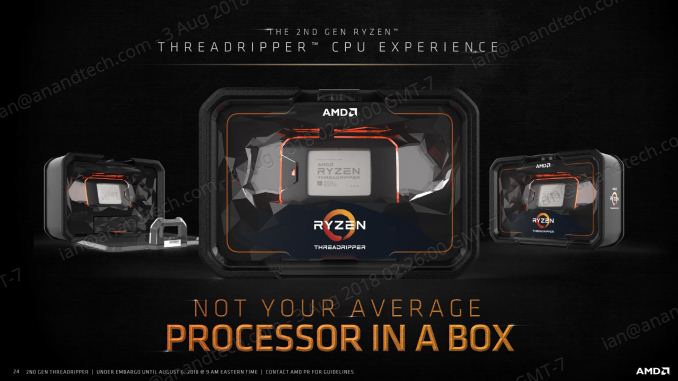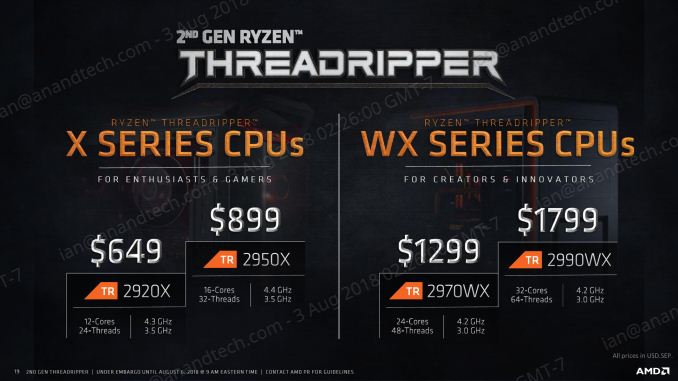The AMD Threadripper 2 Teaser: Pre-Orders Start Today, Up to 32 Cores
by Ian Cutress on August 6, 2018 9:00 AM EST_678x452.jpg)
The biggest news to come out of Computex, AMD’s second generation of its Ryzen Threadripper platform, is almost here. Today’s announcement is all amount images, speeds and feeds, specifications, and an ‘unboxing’ announcement, leading to pre-orders a week before retail. As much as it pains me that there is an unboxing embargo and pre-orders before we even know how the new chips will perform, here we are. Today we get to go through the on-box specifications, discuss the design, and show what AMD included in our press kit.
2990WX Pre-Orders Open Today, Retail August 13th
The formal launch of the new parts is one week from today, and in the biggest markets the first processor of the launch should be available for pre-order. AMD is set to launch four versions of its second generation Ryzen Threadripper over the course of Q3, starting with its flagship 32-core.
| AMD SKUs | |||||||
| Cores/ Threads |
Base/ Turbo |
L3 | DRAM 1DPC |
PCIe | TDP | SRP | |
| TR 2990WX | 32/64 | 3.0/4.2 | 64 MB | 4x2933 | 60 | 250 W | $1799 |
| TR 2970WX | 24/48 | 3.0/4.2 | 64 MB | 4x2933 | 60 | 250 W | $1299 |
| TR 2950X | 16/32 | 3.5/4.4 | 32 MB | 4x2933 | 60 | 180 W | $899 |
| TR 2920X | 12/24 | 3.5/4.3 | 32 MB | 4x2933 | 60 | 180 W | $649 |
| Ryzen 7 2700X | 8/16 | 3.7/4.3 | 16 MB | 2x2933 | 16 | 105 W | $329 |
Sitting at the top of the stack is the 32-core 2990WX, which will retail at $1800, competing directly against Intel’s existing 18-core part, the Core i9-7980XE. AMD is using "WX" in the name here to offer some branding consistency with their high-end workstation graphics models, the Radeon Pro WX series.
Beating at its heart are four 12nm "Zen+" Zeppelin dies, each with eight cores, connected by AMD’s Infinity Fabric, and using simultaneous multi-threading for a total of 64 threads. As with previous generations, there are 60 PCIe 3.0 lanes for add-in cards and storage, and another four lanes for the chipset. There is a slight change in the memory speed, with the new parts supporting DDR4-2933.
Joining the WX line is the Ryzen Threadripper 2970WX, set at $1299 MSRP. This 24-core part uses three cores per CCX (so six cores per die, four dies per package), and also has simultaneous multi-threading for a total of 48 threads. Speeds are equal to the TR 2990WX, with a 3.0 GHz base clock and a 4.2 GHz single core turbo. Per-core turbo speeds will be decided by Precision Boost 2 and XFR2, as explained below. The 2970WX is set for an October launch.
Both of the WX models are hitting the new TDP of 250W, although the way AMD measures TDP is heavily dependent on the cooler used. In this case, their new high-end ‘Wraith Ripper’ cooler is the benchmark, which is developed by Cooler Master. This new cooler is very large, but offers full heatspreader coverage – which as we've discovered is critical for Threadripper cooling – and provides good clearance for memory. It will be sold separately in the channel, at around $100 MSRP.
Also on the table are the 2950X ($899) and the 2920X ($649), which use the existing X branding. This is because these processors are direct replacements for the 1950X and 1920X, using only two active dies in each chip, but this time around are using Zen+, the second generation Ryzen features such as faster caches and better frequency characteristics. The 16-core TR 2950X will have a base frequency of 3.5 GHz, a turbo of 4.4 GHz, and is due to launch on August 31st. The 12-core TR 2920X by comparison also has a 3.5 GHz base frequency, but a slightly lower turbo at 4.3 GHz, and is due out in October. Both of these parts are set at 180W TDP, like the first generation chips.
| AMD Ryzen Product Stacks & Launch Prices | |||
| Ryzen 1000 (2017) | Ryzen 2000 (2018) | ||
| - | TR 2990WX (32C) | $1799 | |
| - | TR 2970WX (24C) | $1299 | |
| TR 1950X (16C) | $999 | TR 2950X (16C) | $899 |
| TR 1920X (12C) | $749 | TR 2920X (12C) | $649 |
| TR 1900X (8C) | $599 | - | |
| Ryzen 7 1800X (8C) | $499 | Ryzen 7 2700X (8C) | $329 |
| Ryzen 7 1700X (8C) | $399 | ||
At this point AMD has not stated if it will expand the family even further, so we don't know if the 1900X will stay at the bottom of the stack, be replaced with a 2000 series model, or if it dies off completely.
At this point, AMD’s main competition is still with Intel’s Skylake-X parts. The 32-core 2990 WX will align in price with the 18-core Core i9-7980XE.
| Threadripper 2 vs Skylake-X The Battle (Sorted by Price) |
||||||||
| Cores/ Threads |
Base/ Turbo |
L3 | DRAM 1DPC |
PCIe | TDP | SRP | ||
| Intel | i9-7980XE | 18/36 | 2.6/4.4 | 24.75 | 4x2666 | 44 | 140W | $1999 |
| AMD | TR 2990WX | 32/64 | 3.0/4.2 | 64 MB | 4x2933 | 60 | 250W | $1799 |
| Intel | i9-7960X | 16/32 | 2.8/4.4 | 22.00 | 4x2666 | 44 | 140W | $1699 |
| Intel | i9-7940X | 14/28 | 3.1/4.4 | 19.25 | 4x2666 | 44 | 140W | $1399 |
| AMD | TR 2970WX | 24/48 | 3.0/4.2 | 64 MB | 4x2933 | 60 | 250W | $1299 |
| Intel | i9-7920X | 12/24 | 2.9/4.4 | 16.50 | 4x2666 | 44 | 140W | $1199 |
| Intel | i9-7900X | 10/20 | 3.3/4.3 | 13.75 | 4x2666 | 44 | 140W | $980 |
| AMD | TR 2950X | 16/32 | 3.5/4.4 | 32 MB | 4x2933 | 60 | 180W | $899 |
| AMD | TR 2920X | 12/24 | 3.5/4.3 | 32 MB | 4x2933 | 60 | 180W | $649 |
| Intel | i7-7820X | 8/16 | 3.6/4.3 | 11 MB | 4x2666 | 28 | 140W | $593 |
| AMD | TR 1900X | 8/16 | 3.8/4.0 | 16 MB | 4x2666 | 60 | 180W | $549 |
| AMD | R7 2700X | 8/16 | 3.7/4.3 | 16 MB | 2x2933 | 16 | 105W | $329 |
Across the metrics, AMD has more cores, is competitive on frequency, has more memory channels, more PCIe lanes, and supports higher memory clockspeeds. Intel has lower power, and above 16 cores a slight turbo clockspeed advantage. Meanwhile we already know from Ryzen 2000-series testing that cache speeds are a back-and-forth competition, and Intel has a slight IPC advantage. Game on.












101 Comments
View All Comments
gipper51 - Monday, August 6, 2018 - link
It is comical the number of folks who think the only purpose for a high end PC is to play games.rocky12345 - Tuesday, August 7, 2018 - link
This is true 100% I blame a lot of it on the tech sites (not Anandtech of coarse) that try to focus on gaming with CPU's that clearly are made for more than just gaming yes they can game but CPU's like this are designed for so much more. When Anandtech's review comes out I am sure they will have the proper tests done for CPU's like this and yes they may also through in a few games just to show that these CPU's can also do a bit of gaming which is fine.edzieba - Monday, August 6, 2018 - link
"Make a list of the top 15 reasons people who actually do work and could use a high-end workstation to take care of business. Now question: will the Core i9-7980XE be faster atany single one?"I'm in the middle of a rush rollout of quad-core machines to replace several tens of thousands (workdwide, only a 'few' thousand in this building) of dual-octacore-CPU workstations because before purchase and rollout, nobody bothered to look at users' actual workloads. Turns out threaded workloads were exceptionally rare, so all the monster workstations were utterly worthless in real world performance compared to the 'low spec' machines the back office staff were using.
Pretty much any highly threaded workload has already been offloaded to a GPU (or Phi) coprocessor, or moved entirely to a remote HPC cluster. For desktop workstations, threaded workloads are the exception rather than the rule.
edzieba - Monday, August 6, 2018 - link
And this is at a Fortune 5 company, who not only should know better but were repeatedly told their purchasing decision was a terrible mistake. But it's hard to fight simple "more cores is more better!" marketing with specific-use-case benchmarking numbers, eyes start to glaze over.mapesdhs - Monday, August 6, 2018 - link
Also shows that the very people employed to provide proper advice on such things are often the first to be ignored. Been through that lunacy several times when I was a sysadmin.johnnycanadian - Monday, August 6, 2018 - link
Oh man -- I know this may sound quite unethical and downright sketch, but hopefully you, as an enthusiast, can get a few of the older machines sent your way to noodle around with ... or build your own (somewhat TDP/performance obsolete) data centre! :-)edzieba - Monday, August 6, 2018 - link
Nope, they take Data Remanence very seriously (and a good chunk of the drives pass through my hands anyway). A machine that went walking out the building without being processed through bag & tag and scanned by the disposal service would make a lot of people very upset and generally be considered a bad move.rocky12345 - Tuesday, August 7, 2018 - link
Yea they would rather have them sent to the recycle plant and destroyed most likely once the hard drives are removed of coarse. I am just guessing that they send them to the recycle plant to get destroyed maybe they send them off for donations for all I know without the hard drives..lolguyr - Tuesday, August 7, 2018 - link
edzieba: "Turns out threaded workloads were exceptionally rare, so all the monster workstations were utterly worthless in real world performance compared to the 'low spec' machines the back office staff were using."Certain industries benefit greatly. I worked in software development, and many-core workstations are a great benefit. Developers typically run the entire stack locally: database, app/web server, and client, so they can find where the problems are without affecting coworkers. Each one of those platforms is multi-threaded (or multi-process), so 40+ threads is common.
Your general point is true, and has been for decades: be aware of your runtime environment, and allocate resources which reflect those realities.
jospoortvliet - Tuesday, August 7, 2018 - link
I must say it surprised me to discover even excel and other office apps are slowly going multithreaded though... as are browsers, with Chrime earlier and now Firefox leading. If you can do even CSS and JavaScript multithreaded every normal computer user suddenly benefits. I doubt they get benefit beyond 16 threads soon but a hyperthreaded octacore is finally useful for a normal user and ibcannimagine a heavy multitasking desktop office worker keeping 16 real/32 logical cores busy. I know i have run out of space on my quad-core years ago and i hope AMD brings more than 8 cores to mainstream soon as threadripper is a tad expensive...